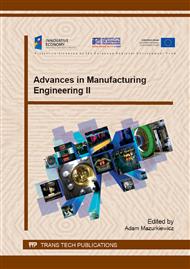p.215
p.221
p.227
p.233
p.239
p.245
p.251
p.257
p.263
Device for Low-Cost Assembly of Chips in RFID Inlays
Abstract:
Security systems employ the RFID method to protect objects and data and to ensure public safety and the safety of commercial activity, e.g. through the control over technological processes. The research activity aimed at improving the level of safety of electronic and technical protection needs to be verified through the manufacture of prototype IDs with RFID inlays.The authors presents an original experimental device enabling the implementation of individual chips in RFID inlays, which were made on a flexible base to which an RFID antenna is attached. The collection of the chip from the dispenser and an unambiguous orientation of the soldered tips in relation to the antenna are provided by a four-axis vacuum manipulator cooperating with a vision system identifying the location of the chip on the manipulator and its final application area. A computer control system enables the operation in two modes, i.e. a semi-automatic mode in which it is possible to manually control the order and the way in which individual tasks are performed, and an automatic mode conducted according to the designed algorithm. The developed device is intended for research on the ways to improve the manufacturing techniques and electronic document protection by means of RFID technologies.
Info:
Periodical:
Pages:
239-244
Citation:
Online since:
August 2015
Authors:
Keywords:
Price:
Сopyright:
© 2015 Trans Tech Publications Ltd. All Rights Reserved
Share:
Citation:


